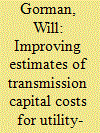|
|
|
Sort Order |
|
|
|
Items / Page
|
|
|
|
|
|
|
| Srl | Item |
| 1 |
ID:
111458


|
|
|
|
|
| Publication |
2012.
|
| Summary/Abstract |
In Iran, there are more than 15,000 MW of wind power potential, but only about 90 MW have been installed since 2009. Because fuel costs are the main part of fuel-consumed power generation costs and fossil resource costs are highly subsidized in Iran, renewable energies such as wind power have yet to be fully developed. This analysis sets out to evaluate the total generating costs of wind power and conventional power plants in Iran. A levelized cost approach was conducted that included investment costs, O&M costs, fuel costs and external costs of emissions for each type of technology. Comparison of cost assessments of power generation show that by taking into account global fuel prices and incorporating air pollutant externalities, wind power can be as competitive as conventional power plants. This paper suggests that a subsidies targeting law would significantly affect the development of the Iranian wind power industry in the future.
|
|
|
|
|
|
|
|
|
|
|
|
|
|
|
|
| 2 |
ID:
107501


|
|
|
|
|
| Publication |
2011.
|
| Summary/Abstract |
A spatial financial model using wind data derived from assimilated meteorological condition was developed to investigate the profitability and competitiveness of onshore wind power in the contiguous U.S. It considers not only the resulting estimated capacity factors for hypothetical wind farms but also the geographically differentiated costs of local grid connection. The levelized cost of wind-generated electricity for the contiguous U.S. is evaluated assuming subsidy levels from the Production Tax Credit (PTC) varying from 0 to 4 ¢/kWh under three cost scenarios: a reference case, a high cost case, and a low cost case. The analysis indicates that in the reference scenario, current PTC subsidies of 2.1 ¢/kWh are at a critical level in determining the competitiveness of wind-generated electricity compared to conventional power generation in local power market. Results from this study suggest that the potential for profitable wind power with the current PTC subsidy amounts to more than seven times existing demand for electricity in the entire U.S. Understanding the challenges involved in scaling up wind energy requires further study of the external costs associated with improvement of the backbone transmission network and integration into the power grid of the variable electricity generated from wind.
|
|
|
|
|
|
|
|
|
|
|
|
|
|
|
|
| 3 |
ID:
169870


|
|
|
|
|
| Summary/Abstract |
Estimating the overall costs of transmission needed to integrate variable renewable energy (VRE) onto the grid is challenging. An improved understanding of these transmission costs would support electricity system planning as VRE penetrations increase. This paper brackets VRE transmission capital costs using multiple approaches based on interconnection studies, actual transmission projects, capacity-expansion simulation models, and aggregated U.S. VRE-related transmission expenditures. Each approach possesses advantages and drawbacks, and combining the approaches lends confidence to the results. The resulting range of average levelized VRE transmission costs is $1–$10/MWh, which is generally lower than earlier estimates in the literature. These transmission capital costs can increase the direct plant-level levelized cost of VRE by 3%–33%, based on levelized costs of energy of $29–$56/MWh for utility-scale wind and $36–$46/MWh for utility-scale solar. As VRE deployment continues to expand, policy makers can use this information to (1) assess the benefits of transmission avoidance and deferral when comparing distributed energy resources versus utility-scale projects, (2) evaluate the potential costs of large-scale public transmission investments, and (3) better analyze system-level costs of utility-scale VRE technologies. Future research can expand on the framework presented here by providing a review of operation and maintenance costs for transmission systems.
|
|
|
|
|
|
|
|
|
|
|
|
|
|
|
|
| 4 |
ID:
109683


|
|
|
|
|
| Publication |
2011.
|
| Summary/Abstract |
Offshore wind offers a very large clean power resource, but electricity from the first US offshore wind contracts is costlier than current regional wholesale electricity prices. To better understand the factors that drive these costs, we develop a pro-forma cash flow model to calculate two results: the levelized cost of energy, and the breakeven price required for financial viability. We then determine input values based on our analysis of capital markets and of 35 operating and planned projects in Europe, China, and the United States. The model is run for a range of inputs appropriate to US policies, electricity markets, and capital markets to assess how changes in policy incentives, project inputs, and financial structure affect the breakeven price of offshore wind power. The model and documentation are made publicly available.
|
|
|
|
|
|
|
|
|
|
|
|
|
|
|
|
|
|
|
|
|